
In nature, clusters of fruit, flowers, plants, ice crystals, even constellations stand out. The individual units take on more importance by being associated or grouped with like-units.
The same goes for content. In fact, content topic clusters represent a better way to organize your website content so it stands out, given changes in search behavior.
According to the definition Google kindly offered me (see image below), a cluster is "a group of similar things or people positioned or occurring closely together." The term has application in astronomy, linguistics, chemistry.... and also inbound marketing. The concepts that matter here are similarity and grouping.
What are Content Topic Clusters?
Content clusters group similar content together so your content stands out (i.e., think forest for the trees).
More specifically, a topic cluster is a series of topically related content intended to build authority and influence in the eyes of search engines and visitors.
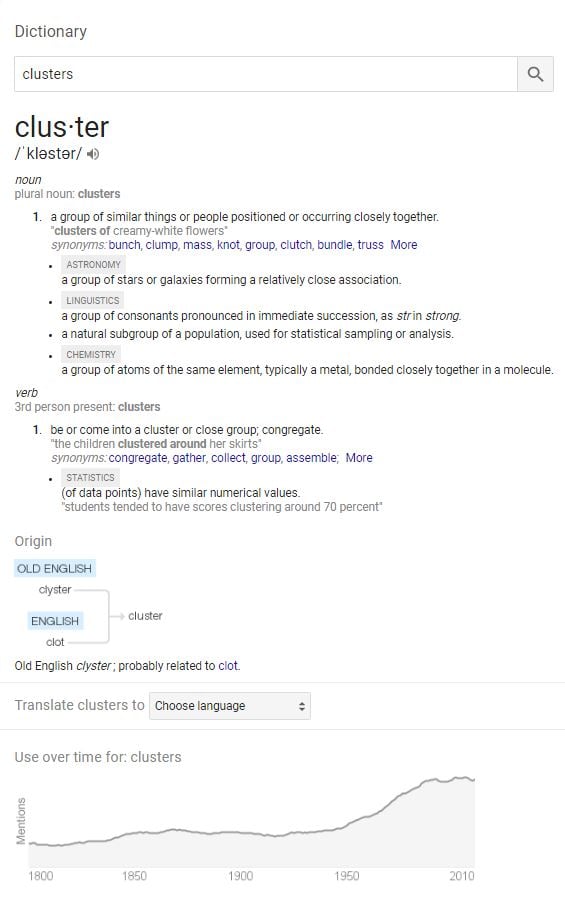
From our online marketing perspective, a topic cluster consists of:
- Pillar content
- Cluster-Subtopic content
- Internal links (i.e., bonds of togetherness)
What is Pillar Content?
A content pillar consists of broad, evergreen and ungated website content that's comprised of, and connected to, a topic cluster that covers a topic in-depth.
Generally, it's a landing page or website page, ideally on the top-level of a domain, where the content is available without having to complete a form, comprehensive (several 1000 words), contains numerous conversion points and/or a form. Tips include:
- Provide content that matches the search intent
- Include your overall topic in the title and meta description
- Add synonyms/related content into the page
- Include various types of media (images, video, etc.)
- Include it prominently in navigation on your site.
>> See The Ultimate Guide to Pillar Content for Your Website
What is Cluster-Subtopic Content?
Subtopic content is a specific piece of content based on a long-tail keyword, or niche question, often in the form of a blog post that links back to the pillar content.
The subtopic must link to the main pillar in the topic cluster. Why? Because the interlinking is what makes content topic clusters so effective.
Here's a visual where "sales qualification" is the pillar core topic in the middle. Around it are satellite subtopics (e.g., when to disqualify, what is BANT, qualifying leads, etc.), each connected to the pillar content with hyperlinks.
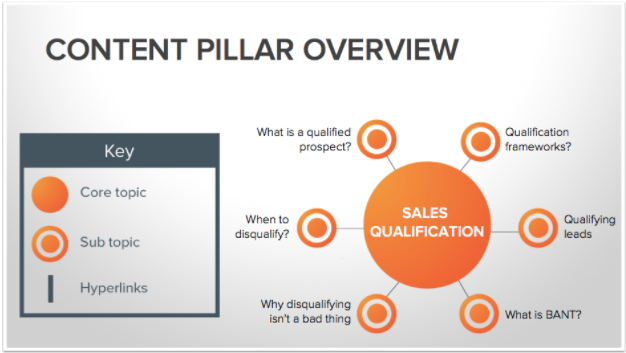
Notice how the core topic - sales qualification - is broad enough to easily accommodate multiple related subtopics.
You will want to develop blog articles around those subtopics and then link to the core content pillar topic. As relevant, you can link back to the subtopics. The linking is how you communicate to search engines that the pillar page is important and that the similar topics add to the overall topic's weight.
You will want to identify a minimum of 8 subtopics to support your pillar. If you think of the questions customers have about the problems you solve for them, you can easily come up with that many and more.
Why Clusters of Topics?
As a content creator, inbound marketer and someone who's interested in ensuring that your website and business actually connect with your prospects, you need to consider creating clusters of related topics.
The reason has to do with how search has changed.
- We search the way we talk (i.e., natural language search is more likely to deliver quality results than exact-match keyword terms), including using voice.
- Furthermore, search engines are getting better at recognizing semantically related concepts.
- Search engines add context based on where you are when you search, time of day, how you format the query, what kind of device you are using and other clues including your own search history. What you see will most likely be completely different than what another person sees for the same query.
- The search engines want to deliver the most relevant and authoritative results possible - including images, knowledge graph and featured snippets.
- This combined with personalized results means that the traditional interpretation of rank and 10 results per search page is morphing.
Combine all of those changes in search behavior with the explosion of content, not all of which is helpful!
The result: it's harder to stand out on the basis of individual articles - even if each is fantastic.
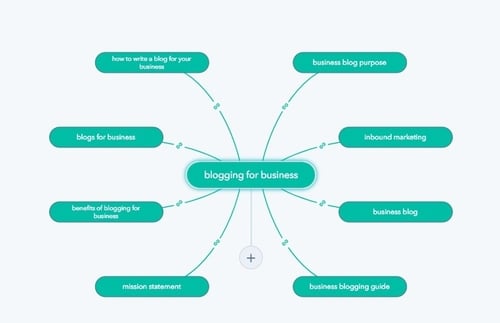
Topic Groupings Help You Get Found in Search
The solution to all of these dilemmas is to focus on and group your content into a core number of content clusters.
Again, think forest rather than trees. Rather than creating thousands of blog articles around a multitude of keywords (i.e., a bunch of trees hanging out haphazardly), group those ideas into related topics (i.e., group the trees into a cluster or forest). This allows you to go deeper with your content. It also helps you establish authority around that content topic.
Ideally, your topic groupings are so intensely relevant to your business that they are not only evergreen, but constantly evolving. Which means that you have evergreen blog article topics you can update on an ongoing basis (i.e., take existing blog articles, unpublish them, update them and then republish them).
As the content evolves, you can update both the core and the subtopics on a regular basis as relevant information becomes available.
With content topic clusters, you are looking to deliver results that both search engines and humans (aka your buyer personas) will delight in because you are truly solving for the questions that searchers ask. It's the best of both worlds when done right.
Think Content 'Wikipedia for your Industry'
Another way to look at this is in terms of a Content Hub that aggregates related content (i.e, clusters similar topics) so it stands out.
As Andy Crestodina says in Content Hubs: How to Beat the Big Boys in 7 Steps,
"Be the Wikipedia for your industry. Be the People Magazine for the influencers relevant to your audience. Don’t make a page, make a section. Don’t write a blog post, write a series."
Think 'communicating in constellations'
In thinking about star clusters, I'm reminded of Steve Rubel Talks Inbound Content Challenges at #INBOUND15 who discussed the need to communicate in constellations. He highlighted how Disney embraced systems thinking to connect all aspects of the Magical World of Disney experience.
Realize that the image below represents a pre-digital illustration showing how the various Disney dots (or subtopics) connect or cluster around the core moving picture storytelling content.
Note the directional links, too.
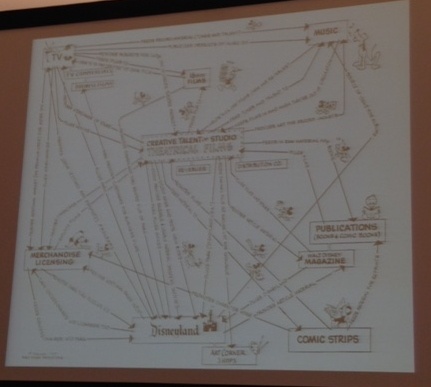
How to Create Cluster-Subtopic Content
So, how to create clusters around topics? Here are eight steps:
Step 1: map out the core problems of your persona
Map out 5-10 core problems that your core persona has. Use research - e.g., surveys, customer interviews, forums, etc. - to truly understand your buyer persona problems, including the words used to describe them. Don't overlook the frequently asked questions prospects and customers ask.
Step 2: group those problems into broad core pillar topics
Group each problem into broad topic areas. These will become your content pillars around which you'll cluster subtopics.
Step 3: build out core topics with subtopics and content ideas
Using keyword research, identify subtopic content that relates to the core topics you've identified. Aim for a minimum of 8 subtopics for each pillar.
As you develop subtopic content, think in terms of semantic search i.e., related concepts rather than exact match topics. Be sure to explore the topics that Google suggests when you type in a search query. Also check out the section at the bottom of the search results page for related searches.
- Content Marketing Strategy
- Brainstorming Techniques
- Blogging
- Blogging Mistakes
- Buyer Personas
- Writing Skills
- Writing Productivity
- Buyer’s Journey
- Gated Content
- Growing Readership
- Content Planning
- Content Creation Tools
- Blog Post Topics
- Grammar Fails
- Post Types
- Scaling Content Output
Step 4: examine your existing content
Review your existing blog articles and other relevant web content and sort them according to the broad topics you identified. You might also pull your top ranking URLs and queries from Google Search Console to understand and identify how well your existing content supports the topics. A high ranking, high traffic page could make for a perfect pillar page with a few copy changes.
Identify content gaps.
Map out content ideas that align with each of the core topics and corresponding subtopics.
Step 5: validate each idea
Review the topics based on domain authority, monthly search volume, and relevancy. Depending on the tool you use, you might include difficulty instead of relevancy. If the topics aren't worthwhile to develop (i.e., no volume, no relevance, high difficutly and no similarity), consider new ones.

Step 6: create the content and link as appropriate
Next, create your content pillar and your subtopic clusters. In addition to word-based content (e.g, web pages, blog posts and other articles), consider visual based-content (images, slide presentations, infographics, videos, etc.) to support your topics.
Be sure to link your subtopics to the pillar, using the correct anchor text. Try to include your core topic keyword, too. As appropriate, link some subtopics to one another. This formalizes the content topic cluster and helps share domain authority.
If you are repurposing existing content, you may want to consolidate duplicate pages as well as update (i.e., refresh, remove existing links and relink to the core topic) the content you do use and optimize.
Here's how HubSpot reorganized its sales blog using the Clustering Model for their content: How We Used the Pillar-Cluster Model to Transform Our Blog.
Although sometimes you build content and the world flocks to your brilliance, most times you need to create your own awareness. For that reason, don't forget to come with a plan for promoting your content via social channels, reaching out to your network, emailing your contacts and even testing paid social and search ads.
Remember that your content doesn't exist in a void. Connect with those who influence your space. You may discover opportunities to contribute brilliance, not to mention receive it.
Step 8: monitor, analyze, review
Once you've created your cluster of content, don't forget about it!
Be sure to monitor and review results. Analyze what's working and not working so you can tweak for new insights. Then, rinse, wash and repeat.

Tools to Use for the Content Cluster Process
At the heart of creating effective content clusters is conducting sound keyword research (that's right, keywords haven't disappeared).
If you noticed with the 'content marketing' cluster above, only one subtopic "content marketing strategy' repeats the core topic words. And only three refer specifically to 'content.' The goal is to identify distinct topics that relate semantically to the core topic.
To do that, you'll need tools. Here are some to consider:
1. Latent Semantic Indexing Search Tools
3 Best LSI Keyword Tools For SEO refers to four interesting tools that use semantic search to uncover related keywords:
- LSI Graph
- Keyword Gen
- Keyword Finder
- Twinwrd Ideas
You may need to combine some of these tools with Google Adwords Keyword Planner to provide you with perspective on how popular a search is and how competitive the terms are.
2. Keyword Explorer in Ahrefs
If you use Ahrefs for exploring keyword ideas, you'll notice an interesting feature in Beta called 'parent topic':
"Parent topic determines if you can rank for your target keyword while targeting a more general topic on your page instead. To identify Parent topic we take the #1 ranking page for your keyword and look for the best keyword that this page ranks for."
This reinforces the discipline of thinking of topics over keywords while doing your keyword research.
3. HubSpot's Content Strategy Tool
If you use HubSpot for your website and blog content, you will want to make use of the Content Strategy Tool.
When you create a topic cluster, the tool suggests core topics based on your website's history. Or, you can create one based on your careful keyword research.
For each topic and subtopic, the tool helps you validate whether to pursue the idea based on your site's domain authority, the monthly search volume for that term and how relevant the term is. For the individual subtopic, the tool tells you how similar the subtopic is to the core topic.
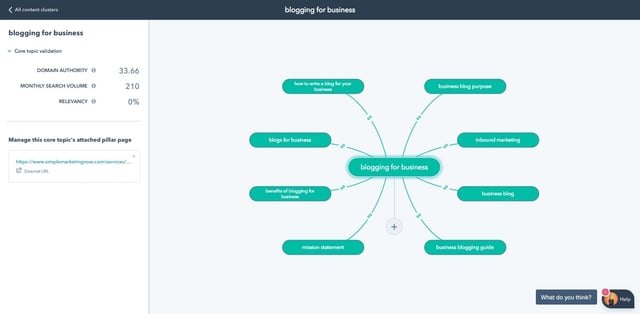
Are you Ready to Get Started with Clusters of Content?
The most valuable aspect of implementing content clustering is that it truly makes you think strategically about the content you create. If you do your homework, and identify those core topics that resonate most with your customer base, you'll have created a body of content (aka clusters or hubs) that help you stand out.
Then, focus on keeping that content evergreen. Update your pillars and refresh/republish your subtopics on a regular basis. In so doing. your content becomes stronger, more complete and more relevant. You wind up with few if any throw-away (i.e., time limited) articles, and the rest of your content truly supports your overall business.
Now, it will take time and effort if you've been publishing for a while to get yourself organized. It also takes focus. However, chances are you'll be surprised by what you discover along the way. I am.
Thanks for reading and let me know of questions.
Oh, and check out the Pillar page I created around the topic cluster of inbound marketing.









